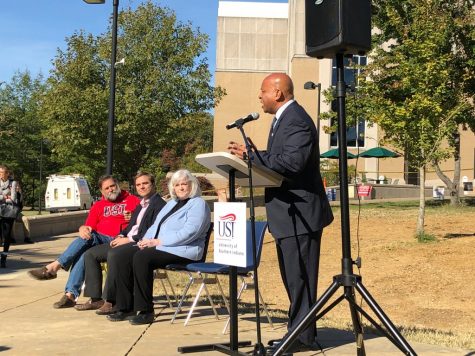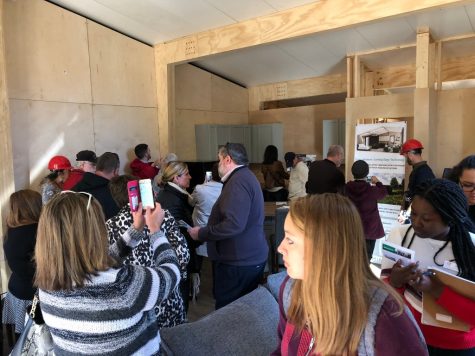Model house paves the way for future housing methods
The university’s partnership geriatrician Bill Thomas and his MAGIC project finally saw concrete results Oct. 24.
The MAGIC project, which stands for multi-ability, multi-generational, inclusive community, is a year-long pilot project that culminated in the construction of a model Minka house.
The project is being funded by the university, the USI Foundation and the American Association of Retired Persons (AARP).

President Ron Rochon speaks to the community and media at the official ribbon-cutting of the model Minka house Oct. 24
The Minka building used robotic manufacturing to construct materials for the house in upstate New York and was transported to Evansville to be assembled. It was built in less than a week at a cost of close to $100,000.
“This house is the world’s first laboratory dedicated to the study of independence,” Thomas said. “We will use this place to make the University of Southern Indiana and the community of Evansville global leaders in a new generation of understanding of what aging brings to us.”
The house was designed by Thomas and AGJ architects, a design firm based in Denmark in an effort to create affordable housing for people of all ages and abilities.
The idea is to create housing that is best suited for aging people in order for them to maintain their independence according to Thomas.
He said the university is going to use this laboratory as a “springboard” to plan for a community of Minka houses near campus, relying on the same concepts and technologies of the model house. He said there is no set timetable for when planning of this community will begin.
These communities are meant to include multi-generational housing, which would include students living in a community with elders.
“When Dr. Thomas was describing this to me, all I could imagine was this ability for students coming together with seniors and having conversations and picking up on these amazing stories, amazing tidbits on how to live wisely, how to do things in a way that really builds civic leadership and underscores citizenry in our country,” President Ron Rochon said at the ribbon-cutting.
The partnership between Thomas and USI arose last year when he spoke in the Performance Center as part of the university’s Mid-America Institute on Aging and Wellness conference. Thomas also brought his Changing Aging Tour to campus in 2017, which led to discussions with university administrators and ultimately, the beginning of the pilot project.

Community members tour inside the model Minka house Oct. 24.
“His passion excites me, this idea excites me,” Rochon said. “I am very thankful that USI has become a leader in this initiative and it’s a wonderful opportunity for us.”
The Minka house will also serve as a laboratory to study the impact of universal-accessibility housing on elderly independence.
A MAGIC class will be offered twice during the upcoming spring semester and will be open to students of any major and members of the community. The class was also offered last spring.
Students in that class evaluated potential sites for the model house on campus and ultimately chose the area between the Red Mango entrance of Forum Wing and the Education Center.
“USI is well known for being a leader in health care, but the MAGIC project is certainly unique in that it represents the intersection of nursing and health professions with other disciplines such as engineering, social work, communal studies, teacher education and many others,” Dean of the College of Nursing and Health Professions Ann White said.
Students in the soil mechanics class met with MAGIC team and performed soil tests to determine gradation or distribution of different size groups within a soil sample.
“It is not often that engineering and health professions have the opportunity to collaborate but that’s what happened with MAGIC,” White said. “This Minka is the spark of what will be many innovations on this campus to improve quality of life for all of us as we age.”


